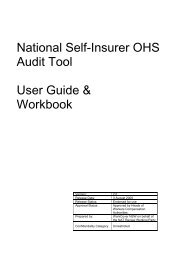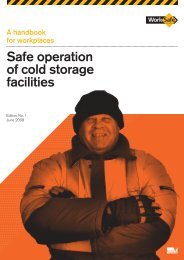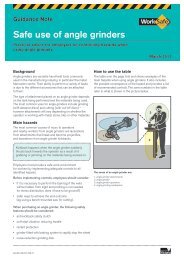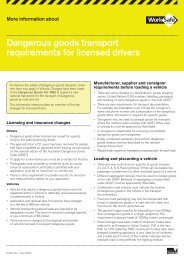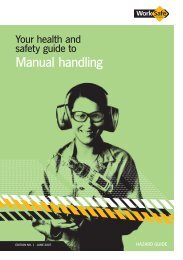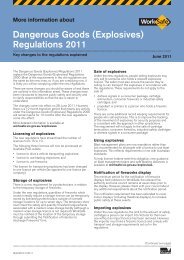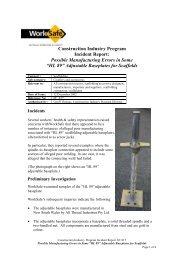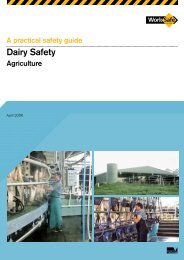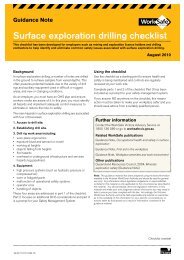Disability services - occupational health and safety compliance kit
Disability services - occupational health and safety compliance kit
Disability services - occupational health and safety compliance kit
- No tags were found...
Create successful ePaper yourself
Turn your PDF publications into a flip-book with our unique Google optimized e-Paper software.
A Health <strong>and</strong> Safety SolutionMoving <strong>and</strong> supporting peoplewith a disabilityWhat is the problem?The task of moving <strong>and</strong> supporting people with adisability has been associated with musculoskeletalinjuries within the disability <strong>services</strong> industry.What are the risks?Workers may be at risk of injuries from strainsto the back, neck <strong>and</strong> shoulders when bending,twisting, lifting, pushing, pulling <strong>and</strong> exerting highor unexpected forces.The common sources of risk include:TaskExerting high forces to lift, transfer or movepeople where no equipment or aids are available.Moving unexpectedly or with abrupt forcefulmotions such as when preventing peoplefrom falling.Working in an awkward position forsustained periods (eg assisting with mealsor dressing/undressing).Managing unpredictable client movements orbehaviours such as seizures, expressions ofstrong emotion or self-harm.EquipmentUnsuitable equipment or aids.Faulty equipment or aids.No equipment or aids.EnvironmentInsufficient space for workers to use equipment.Equipment or aids stored in inaccessible locations.Inappropriate working heights.Thick carpets or soft underlay on floor.Different floor levels.Uneven surfaces.These issues should be considered during theinitial assessment of the person’s needs <strong>and</strong> ifthey pose a risk, must be controlled prior to theprovision of service.What are solutions to the problem?The risk of injury to workers can be eliminatedor reduced by the following <strong>safety</strong> measures:Equipment/aid provision <strong>and</strong> useWhen supporting a person who requires minimalphysical support, equipment to reduce the risk ofinjury to workers may include:h<strong>and</strong>/grab railselectric st<strong>and</strong> chairmodified/specific chairleg lifterbed stickdining chair with lockable wheelswalking aids such as a frame or stick.When supporting a person who is able topartially assist, additional equipment to reducethe risk of injury to workers may include:electric hi-lo bedst<strong>and</strong>ing hoist to lift person into a supportedst<strong>and</strong>ing position, to transfer from one locationto another, or when assistance is requiredmobile sling hoist to lift <strong>and</strong> transfer peopleshort distancesslide sheetslide boardhi-lo change tableheight-adjustable ergonomic chair for workerssock/stocking applicatorWhen a person requires full support, additionalequipment to reduce the risk of injury to workersmay include:overhead tracking hoist to move person fromthe floor, chair or bedwheelchair with electric motor.Ensure transfer equipment <strong>and</strong> aids are:suitable for the taskeasy to use <strong>and</strong> manoeuvremaintained in good working order.HSS0128/01/01.10(Health <strong>and</strong> Safety Solution continued overleaf).
A Health <strong>and</strong> Safety SolutionEnvironmentReduce clutter.Provide adequate working space.Use furniture <strong>and</strong> equipment that is light,compact <strong>and</strong> easy to move where necessary.Assess floor surfaces for suitability for movingany wheeled equipment <strong>and</strong> make appropriatemodifications if required (vinyl or low pile carpet).Store equipment in a convenient location.Adjust transfer surfaces to support movementat approximately the same level (eg from bedto wheelchair).TaskAllocate two workers for transfers for a personwho requires full or partial assistance.Develop <strong>and</strong> implement a system so the transferThe problemExerting high forces to lift, transfer or move people where noequipment or aids are available.A solutionMobile electric hoists may be used for tasks such as lifting peoplefrom bed to chair, chair to toilet, bed to trolley <strong>and</strong> up from the floor.of a person will not proceed until a secondworker is available.Develop <strong>and</strong> implement a system to regularlyseek information from the worker to check ifthe work environment, tasks or person’s needshave changed or need to change.Regularly review the person’s mobility <strong>and</strong>behavioural requirements with worker <strong>and</strong>person to identify potential changes to clientcare, update relevant documentation <strong>and</strong><strong>occupational</strong> <strong>health</strong> <strong>and</strong> <strong>safety</strong> controls.If changes have been made or need to be made,employers should complete a re-assessmentof the worker’s tasks <strong>and</strong> environment. Fix any<strong>safety</strong> issues as soon as possible so the worker’s<strong>and</strong> person’s needs are safely met.Train workers in using equipment, aids <strong>and</strong>specific task or work instructions. Update thetraining regularly.Further InformationWorkSafe Advisory ServiceToll-free 1800 136 089Email info@worksafe.vic.gov.auworksafe.vic.gov.auRelated WorkSafe Health <strong>and</strong> Safety SolutionsSupporting people with personal hygiene careAssisting people in wheelchairsH<strong>and</strong>ling wheelchairs in <strong>and</strong> out of vehiclesOccupational violenceMoving/lifting objectsVacuumingMoppingCleaning bathroomsMaking bedsWork related driving: Transporting people <strong>and</strong>moving equipmentRelated WorkSafe publicationsManual H<strong>and</strong>ling Code of Practice, 2000Transferring people safelyOther related publicationsVictorian home care industry <strong>occupational</strong> <strong>health</strong><strong>and</strong> <strong>safety</strong> guide, 2005Department of Human Services, Accommodationst<strong>and</strong>ards <strong>and</strong> design guidelines – Sharedsupported accommodation, 2004Available fromworksafe.vic.gov.au <strong>and</strong> <strong>health</strong>.vic.gov.au2
A Health <strong>and</strong> Safety SolutionSupporting people with personalhygiene careWhat is the problem?Providing support with personal hygiene tasks,such as showering or toileting, to people with adisability has been associated with musculoskeletalinjuries in the disability <strong>services</strong> industry.What are the risks?Workers may be at risk of injuries from strains to theback, neck <strong>and</strong> shoulders when bending, reaching,twisting <strong>and</strong> exerting high or unexpected forces.The common sources of risks include:TaskA mismatch between the assistance required bythe person <strong>and</strong> the documentation identifyingtheir physical support needs.Aids <strong>and</strong> equipment not being provided <strong>and</strong>/orused when assessed as necessary.Unexpected <strong>and</strong> unplanned movement by the person.EnvironmentInadequate space to shower/bath/toilet the person.Wet or slippery floors.EquipmentUnsuitable equipment or aids.Faulty equipment or aids.No equipment or aids.These issues should be considered during the initialassessment of the client’s needs <strong>and</strong> any risks identifiedshould be controlled prior to provision of service.What are solutions to the problem?The risk of injury to workers can be eliminatedor reduced by the following <strong>safety</strong> measures:SystemsIdentify hazards <strong>and</strong> address the risks associatedwith bathing, toileting or showering the personwith a disability, taking into account the level ofsupport the person requiresConduct an individualised assessment regardingthe physical support needs of the client, includingequipment <strong>and</strong> aids requiredHSS0127/01/01.10Identify <strong>and</strong> implement risk control measures<strong>and</strong> integrate <strong>occupational</strong> <strong>health</strong> <strong>and</strong> <strong>safety</strong>(OHS) controls into the client’s support plan(This information can also be recorded in aseparate OHS plan)Provide workers with information, instruction <strong>and</strong>training on the client’s physical support needs,including OHS controlsEncourage the person with a disability to activelyparticipate <strong>and</strong>/or contribute to physical supporttasks where possible.Implement systems to:regularly seek information from the worker tocheck if their work environment, tasks or client’sneeds have changed, or need to changere-assess the tasks <strong>and</strong> environmentupdate <strong>and</strong> document the client’s physicalsupport planmonitor the implementation <strong>and</strong> use of OHScontrols so the worker’s <strong>and</strong> client’s needs aresafely metprovide a system so workers can report anychanges or <strong>safety</strong> issues to their employerprovide workers with training in specific tasksor work instructions.Equipment/aid provision <strong>and</strong> useEquipment or aids to support a person witha disability <strong>and</strong> undertake personal hygienetasks are:assessed as suitable for the taskappropriate for the space (eg hoists orshower chair)available, easy to access from storage, setup <strong>and</strong> useinstalled or supplied prior to servicecommencingmaintained in good working orderassessed as appropriate for the needs ofthe person with a disability <strong>and</strong> safe for useby the worker.(Health <strong>and</strong> Safety Solution continued overleaf).
A Health <strong>and</strong> Safety SolutionAssisting people in wheelchairsWhat is the problem?The task of assisting people in wheelchairs hasbeen associated with musculoskeletal injurieswithin the disability <strong>services</strong> industry.What are the risks?Workers may be at risk of injuries to the back,neck, shoulders <strong>and</strong> wrists when assisting peoplein wheelchairs, particularly from pushing, pulling,bending <strong>and</strong> exerting high forces.The common sources of risk include:EquipmentWheelchairs that are not maintained or poorlymaintained (eg flat tyres, brakes not working, loosewheels, castors <strong>and</strong> damaged upholstery/frame).Wheelchairs that are not suitable for the client<strong>and</strong>/or environment.Repairs <strong>and</strong> modifications conducted byunauthorised or unqualified people.Failure to charge electric batteries.TaskEffort involved in pushing the combined weightof the wheelchair <strong>and</strong> client.Pushing wheelchairs long distances.Transferring people in/out of wheelchairs.Pushing an electric wheelchair in free wheel mode.Driving electric wheelchairs when usingattendant controls.EnvironmentSoft floor surfaces such as deep pile carpets,rugs, lino with soft underlay.Inadequate space to manoeuvre wheelchairs.Pushing wheelchairs over steep or unevensurfaces (eg grass, gravel, curbs, ramps).Controlling wheelchairs up <strong>and</strong> down ramps.Inadequate information about wheelchair accessibility.What are solutions to the problem?Implement a system to inspect <strong>and</strong> review theworkplace <strong>and</strong> equipment, <strong>and</strong> identify anychanges in the individual’s needs.If changes have been made or need to be made,employers should complete a re-assessment of theworker’s tasks <strong>and</strong> environment.Fix any <strong>safety</strong> issues as soon as possible so theworker’s <strong>and</strong> client’s needs are safely met.The risk of injury can be eliminated or reduced bythe following <strong>safety</strong> measures:EquipmentInvolve workers in assessment <strong>and</strong> selection ofa wheelchair in relation to:the client’s needsworker <strong>safety</strong>environment where wheelchair will be usedease of operation for client <strong>and</strong> workersneed for attendant controls onelectric wheelchairs.Regularly maintain <strong>and</strong> inspect wheelchairs (egchecks on tyre pressure, brakes, controls, tyrewear, fabric/structure, charging point <strong>and</strong> batterycondition). If the wheelchair is client owned,include this requirement in the service agreement.TaskDevelop procedures to identify the safestmovement of the wheelchair <strong>and</strong> client.Provide workers with training in the use ofwheelchairs including:going up <strong>and</strong> down curbs, controlling onslopes, managing small lips of ramps, turningpractical supervised training exercises at arange of community locations (cafes, trainstations, cinema)information provided by manufacturer <strong>and</strong>/orsupplier if available.HSS0125/01/01.10(Health <strong>and</strong> Safety Solution continued overleaf).
A Health <strong>and</strong> Safety SolutionEnvironmentAssess floor surfaces for minimal friction to assistease of movement. Where necessary, modifyexisting flooring.Provide adequate space to manoeuvre(eg appropriate door widths).Develop <strong>and</strong> implement a system so if changes aremade to the home or environment, the organisationproviding the support is notified (eg installation orremoval of a portable ramp, home renovation).Conduct a pre-visit assessment of accessibilitybefore engaging in community-based activities.Avoid s<strong>and</strong>, loose stone or dirt paths when usingindoor wheelchairs.The problemPushing wheelchairs over steep, uneven or soft surfaces can putthe worker at risk of injury to the back, neck <strong>and</strong> shoulders.A solutionFurther InformationWorkSafe Advisory ServiceToll-free 1800 136 089Email info@worksafe.vic.gov.auworksafe.vic.gov.auRelated WorkSafe Health <strong>and</strong> Safety SolutionsMoving <strong>and</strong> supporting people with a disabilitySupporting people with personal hygiene careH<strong>and</strong>ling wheelchairs in <strong>and</strong> out of vehiclesOccupational violenceMoving/lifting objectsVacuumingMoppingCleaning bathroomsMaking bedsWork related driving: Transporting people <strong>and</strong>moving equipmentRelated publicationsDepartment of Human Services, Accommodationst<strong>and</strong>ards <strong>and</strong> design guidelines – Sharedsupported accommodation, 2004Victorian home care industry <strong>occupational</strong> <strong>health</strong><strong>and</strong> <strong>safety</strong> guide, 2005Available fromworksafe.vic.gov.au <strong>and</strong> <strong>health</strong>.vic.gov.auAustralian St<strong>and</strong>ardsAS/NZS 3856:1998, Hoists <strong>and</strong> ramps forpeople with disabilities – Vehicle-mounted –Product requirementsAS/NZS 2640:1994, Portable ramps for vehiclesAS3693 – Wheelchairs—Nomenclature, terms<strong>and</strong> definitionsAS3695 – Wheelchairs—Product requirementsAS3696 – WheelchairsISO 10542-1:2001,Technical systems <strong>and</strong> aids fordisabled or h<strong>and</strong>icapped persons – Wheelchairtie down <strong>and</strong> occupant – restraint systemsOutdoors, avoid s<strong>and</strong>, loose dirt, dirt paths when using indoorwheelchairs. Indoors, avoid thick pile carpet <strong>and</strong> rugs <strong>and</strong> lino withsoft underlay.2
A Health <strong>and</strong> Safety SolutionH<strong>and</strong>ling wheelchairs in <strong>and</strong>out of vehiclesWhat is the problem?Moving wheelchairs in <strong>and</strong> out of vehicles has beenassociated with musculoskeletal injuries to workers.What are the risks?Workers may be at risk of injuries to the back<strong>and</strong> shoulders when moving wheelchairs in <strong>and</strong>out of vehicles, particularly when lifting, reaching,pushing, pulling, bending <strong>and</strong> exerting high forcesin awkward postures.The common sources of risk include:WheelchairsSize <strong>and</strong> weightAwkward shapeRigid or collapsible typeInflatable or rigid tyresTaskMoving or lifting a wheelchairDisassembling a wheelchair into componentparts to assist with transportationVehiclesLack of appropriate transport, space orattachment points, specifically:Vans/buses/taxisPositioning wheelchairs in the vehicleAttaching a wheelchair to points inside vehicle(eg in floor tracking, A frames or mini A frames)Inadequate space to manoeuvre (eg whenattaching front wheels to security straps).CarsLack of equipment to lift wheelchair in <strong>and</strong> out of carPositioning a wheelchair in the bootType of car/boot accessLifting a wheelchair up high to avoid damagingcar panels.These issues should be considered during the initialassessment of the client’s need <strong>and</strong> if they posea risk to workers, should be controlled prior to theprovision of service.HSS0124/01/01.10What are solutions to the problem?Implement a system to regularly seek informationfrom the worker to check if the work environment,tasks, equipment or client’s needs have changed,or need to change.If changes have been made or need to be made,employers should complete a re-assessment of theworker’s tasks, equipment <strong>and</strong> environment.Fix any <strong>safety</strong> issues as soon as possible so theworker’s <strong>and</strong> client’s needs are safely met.The risk of injury can be eliminated or reduced bythe following <strong>safety</strong> measures:EquipmentProvide the lightest wheelchair that is suitable<strong>and</strong> safe for the client <strong>and</strong> activity.Provide manual wheelchairs that are collapsiblewith quick release wheels.Never lift electric wheelchairs or motorisedvehicles such as a scooter. These should onlybe moved in a wheelchair accessible taxi or busfitted with a hoist or a specially adapted vehicle.(Health <strong>and</strong> Safety Solution continued overleaf).
TaskDevelop operational procedures that identify thesafest sequence of actions for:disassembling the wheelchair into small parts(eg removal of quick release wheels)moving <strong>and</strong> lifting wheelchairs, including theidentification of parts of the wheelchair to beused as leverage/lifting points.Develop a pre-trip assessment checklist thatincludes detailed accessibility questions relatingto the specific requirements of clients.Complete a venue checklist for all activities.Hire manual wheelchairs <strong>and</strong> scooters at shoppingcentres to eliminate the need to transport a wheelchair.Contact the shopping centre prior to a visit to check:hiring conditionsthe condition <strong>and</strong> suitability of the chair(eg tyre pressure <strong>and</strong> brakes)the environment (eg ramps <strong>and</strong> access to car park).VehiclesEmployers should assess vehicles as suitable for thetask <strong>and</strong>/or provide appropriate transport to reducerisks to the worker <strong>and</strong> client. Vehicles include:the service provider’s specially adapted vehicle(eg rear entry accessible vans)the client’s specially adapted vehiclethe service provider’s carsuitably trained transport providersbus fitted with a hoistthe worker’s own car.Vans/buses/taxisInstall vehicle attachment points by qualified<strong>and</strong> accredited professionals to approved<strong>safety</strong> st<strong>and</strong>ards.Develop operational procedures that identifythe safest sequence of actions for:loading/unloadingsecuring the wheelchair during transit.Provide workers with information, instruction <strong>and</strong>supervision in documented work procedures.Obtain approval from the Vehicle AssessmentSignatory Scheme (managed by VicRoads) where anymodifications have been/will be made to a vehicle.Use wheelchair accessible taxis to transportmanual <strong>and</strong> power wheelchairs <strong>and</strong> scooters.Note: Taxi drivers may provide assistance withboarding <strong>and</strong> securing the wheelchair or scooterbut may not be required to assist.Scooter loaders fixed to the floor of the vehicle thatuse an electric drive to lift <strong>and</strong> lower the scooter<strong>and</strong> rotating arm to swing it into the luggagecompartment or boot. Some loaders can be usedwith a range of scooters <strong>and</strong> power wheelchairs.2
A Health <strong>and</strong> Safety SolutionCarsUse aids to reduce risks such as:wheelchair carriers mounted to the tow bar of avehicle. Other options allow the wheelchair to berolled onto the carrier with minimal lifting or requirethe wheelchair to be lifted <strong>and</strong> hung off hookselectrically operated wheelchair hoists with awinch to raise <strong>and</strong> store the wheelchair on theback or in the boot of a vehiclewheelchair ramps to allow a wheelchair or scooterto be loaded into a van or station wagon. Rampscan be freest<strong>and</strong>ing or mounted to the tow barscooter <strong>and</strong> wheelchair trailers allow transportwithout the need to disassemble the equipment.Scooter trailers have a tilting deck to enable ascooter or power wheelchair to be driven on <strong>and</strong>off the trailerIf none of the above is practicable, generalguidelines should apply for foldable manualwheelchairs. These include:using a wagon or hatch vehicle where the foldedwheelchair can be slid straight into the bootremoving other items in the boot to providemaximum space for a wheelchairusing suitable equipment such as a wheelchairboot slider or slide sheet to lift foldablewheelchairs in <strong>and</strong> out of a sedan bootholding wheelchairs as close to the body aspossible when moving wheelchairs to minimiseload when liftingseeking assistance of another personintroducing aids <strong>and</strong>/or attachments to preventthe wheelchair moving further into the boot duringtransport.Any movements or actions involved with using aids<strong>and</strong> equipment to assist in moving unoccupiedwheelchairs should also be assessed to addressmanual h<strong>and</strong>ling risks <strong>and</strong> ensure these risks arecontrolled. For example, lifting <strong>and</strong> manoeuvring rampsinto position for wheelchairs can also cause injuries.3
A Health <strong>and</strong> Safety SolutionThe problemLifting heavy <strong>and</strong> awkward wheelchairs without assistance puts theworker at risk of injury to the back <strong>and</strong> shoulders.A solutionWheelchair carriers mounted to the tow bar of a vehicle reduceslifting <strong>and</strong> reaching for the worker.Further InformationWorkSafe Advisory ServiceToll-free 1800 136 089Email info@worksafe.vic.gov.auworksafe.vic.gov.auRelated WorkSafe Health <strong>and</strong> Safety SolutionsMoving <strong>and</strong> supporting people with a disabilitySupporting people with personal hygiene careAssisting people in wheelchairsOccupational violenceMoving/lifting objectsVacuumingMoppingCleaning bathroomsMaking bedsWork related driving: Transporting people <strong>and</strong>moving equipmentRelated publicationsVictorian home care industry <strong>occupational</strong> <strong>health</strong><strong>and</strong> <strong>safety</strong> guide, 2005Available fromworksafe.vic.gov.au <strong>and</strong> <strong>health</strong>.vic.gov.auAustralian St<strong>and</strong>ardsAS/NZS 3856:1998, Hoists <strong>and</strong> ramps for peoplewith disabilities – Vehicle-mounted – ProductrequirementsAS/NZS 2640:1994, Portable ramps for vehiclesAS3693 – Wheelchairs—Nomenclature, terms<strong>and</strong> definitionsAS3695 – Wheelchairs—Product requirementsAS3696 – WheelchairsISO 10542-1:2001, Technical systems <strong>and</strong> aidsfor disabled or h<strong>and</strong>icapped persons – wheelchairtie down <strong>and</strong> occupant – restraint systems4
More information aboutOccupational violenceThis information sheet provides advice for organisations where jobs that requireface-to-face contact place workers at risk of exposure to <strong>occupational</strong> violence.May 2011BackgroundOccupational violence is any incident in which a personis abused, threatened or assaulted in circumstances relatingto their work. This definition covers a broad range ofbehaviours that can create a risk to the <strong>health</strong> <strong>and</strong> <strong>safety</strong>of workers.In the community <strong>services</strong> sector, other terms may beused for behaviour that fits this definition (eg acting out,challenging behaviour <strong>and</strong> behaviours of concern).Whether it is intended or not, <strong>occupational</strong> violenceis a workplace hazard.OHS laws require employers to ensure risks to <strong>health</strong><strong>and</strong> <strong>safety</strong> are eliminated or reduced so far as is reasonablypracticable.What to look out forThe nature <strong>and</strong> location of work, types of clients, staffinglevels <strong>and</strong> skill mix can all affect the level of risk ofexposure to <strong>occupational</strong> violence.Risks of injury due to <strong>occupational</strong> violence can occurin community service settings where workers interact withother people (eg clients, families <strong>and</strong> members of the public).The common sources of risk include situations where:• individuals are bored, frustrated, anxious, disinterestedor are under the influence of drugs or alcohol• the physical environment creates a potential for harm(eg workplace is poorly maintained or unsecured or thereis no access to safe areas)• information about individuals’ needs <strong>and</strong> behaviour is notknown or available to workers• new clients or individuals are introduced into the environment• causes of behaviour are not well understood(eg triggers for behaviours of concern)• communicating with clients is difficult or ineffective(eg clients cannot communicate their feelings or thesource of discomfort, distress, illness)• workers are assigned without adequate support(eg staffing, supervision, monitoring, information,resources)• work is undertaken with clients in a range ofenvironments (eg home visits, transporting clients,recreational activities)• workers are by themselves or isolated• the way <strong>services</strong> are delivered contributes to clientfrustration (eg long waiting times, refusing <strong>services</strong>,uncomfortable, overcrowded or noisy environments)• <strong>services</strong> <strong>and</strong> clients are not matched• <strong>services</strong> operate at night• unknown people are present in the workplace or wherework is done.What should employers do?Prevention <strong>and</strong> management of <strong>occupational</strong> violencerequires an integrated organisational approach that usessome or all of the following <strong>safety</strong> measures.ConsultationConsultation is essential to prevent <strong>occupational</strong> violence.Employers must consult with <strong>health</strong> <strong>and</strong> <strong>safety</strong>representatives (HSRs) <strong>and</strong> workers, so far as is reasonablypracticable. Consultation must occur when an employer:• identifies or assesses <strong>occupational</strong> violence risks• makes decisions about ways to address <strong>occupational</strong>violence risks• makes decisions about providing information <strong>and</strong> trainingon prevention <strong>and</strong> management of aggression• plans to change the way work is done.Work environment• Ensure physical layout of work areas are designedto reduce risks.• Provide secure areas that are readily accessiblefor workers.• Ensure work areas, access, egress <strong>and</strong> related areasare clearly lit.• Provide a calm environment (eg noise levels, colourschemes <strong>and</strong> temperature).• Keep work areas maintained, clean <strong>and</strong> tidy.• Where <strong>services</strong> are provided in external locations, gather<strong>and</strong> provide information to identify risks <strong>and</strong> implementrisk controls (eg where working at night, in high crimeareas or in confined spaces such as vehicles). Where noinformation is available in relation to external locations,assume a high level of risk.Systems• Have a system for each client that includes:– full, accurate <strong>and</strong> up-to-date information about clients<strong>and</strong> care needs– been developed in consultation with family, friends,relevant professionals <strong>and</strong> other interested peoplewho can provide relevant information– ways to transfer information about clients(eg when they are placed in or exit a service, attendday programs).(Continued over page)MIA026/01/05.11
More information about Occupational violence• Have a system for assessment <strong>and</strong> screening of clients(eg client assessment is done by a suitably qualifiedperson <strong>and</strong> includes an assessment of <strong>occupational</strong>violence risks).• Develop, implement, monitor <strong>and</strong> regularly review clientsupport strategies.• Implement policies that cover the behaviour of visitorsto the workplace (eg client’s friends <strong>and</strong> family members,members of the public), including consequences forinappropriate behaviour.• Eliminate or limit access to objects or areas thatcould be used to harm workers <strong>and</strong>/or other clients.• Provide information <strong>and</strong> training on:– risk factors associated with <strong>occupational</strong> violence– measures in place at the workplace to control risk– workplace policy <strong>and</strong> procedures, including emergency<strong>and</strong> post incident responses, <strong>and</strong> off-site visits– communication strategies <strong>and</strong> skills– positive interventions.• Seek information from workers to check whethertheir work environment, tasks or the client’s needs havechanged, or need to change.Workers <strong>and</strong> staffing• Provide appropriate supervision <strong>and</strong> support to workers.• Provide induction training for workers.• Ensure adequate <strong>and</strong> suitable staffing (eg ensureworkers are matched to care <strong>and</strong> support needs<strong>and</strong> client mix, ensure adequate numbers of workers).• Ensure all staff apply client support strategiesconsistently (eg use behaviour management strategiesin the same way <strong>and</strong> have routines for clients).• Provide communication equipment to workers thatis tested <strong>and</strong> maintained (eg duress alarms).Further informationWorkSafe Advisory ServiceToll-free 1800 136 089info@worksafe.vic.gov.auworksafe.vic.gov.auRelated WorkSafe publicationsPrevention <strong>and</strong> management of aggressionin <strong>health</strong> <strong>services</strong>, 2008Working safely in community <strong>services</strong>, 2006Working safely in visiting <strong>health</strong> <strong>services</strong>, 2006Working alone, 2011Preventing <strong>and</strong> responding to bullying at work, 2009WorkSafe OHS <strong>compliance</strong> <strong>kit</strong>s –Children’s <strong>services</strong>, disability <strong>services</strong>, home care,community support <strong>services</strong>Volunteer <strong>health</strong> <strong>and</strong> <strong>safety</strong> –a h<strong>and</strong>book for community service organisations, 2008Other related publicationsVictorian Home Care Industry OHS Guide, 2005Available from worksafe.vic.gov.au<strong>and</strong> <strong>health</strong>.vic.gov.auResponding to incidentsEmployers should ensure appropriate response measuresare in place where there are risks of <strong>occupational</strong> violence.Workers should be trained on emergency <strong>and</strong> post-incidentresponses, including what to do during an incident.Workplaces should conduct regular drills to test responsesystems.Response actions help reduce the harm caused to a worker<strong>and</strong> assist in preventing future incidents.Responses will vary depending on the scale <strong>and</strong> severityof the incident. Steps taken should include:• ensure staff <strong>and</strong> client <strong>safety</strong>, <strong>and</strong> provide first aid<strong>and</strong>/or medical treatment where required(where necessary contact police <strong>and</strong> ensure emergencyphone numbers are readily available)• provide access to support (eg practical <strong>and</strong> emotional)• provide a coordinated response• record incident details• conduct an incident review/investigation• notify HSRs.2
More information about Occupational violenceOccupational violence: Risk assessment checklistAll employers should carry out a regular check of the workplace in consultation with <strong>health</strong> <strong>and</strong> <strong>safety</strong> representatives<strong>and</strong> workers to identify if there are signs that <strong>occupational</strong> violence is happening or could happen (risk identification),<strong>and</strong> take steps to implement solutions to control risks.This checklist is designed to help employers meet their legal obligations to manage risks associated with <strong>occupational</strong>violence.Follow the checklist to assess the risks <strong>and</strong> list possible solutions to be implemented.This checklist is not exhaustive. You may need to consider other factors that are unique to your workplace. Add theseto the ‘additional factors’ section of this checklist. There are also other tools found in the publication, Working safelyin visiting <strong>health</strong> <strong>services</strong> that you may use to assess risks of <strong>occupational</strong> violence in your workplace (see the examplechecklists for referral information <strong>and</strong> initial <strong>safety</strong> assessment information).If you tick YES to any of the questions below, implement risk control measures such as those mentioned under‘solutions for <strong>occupational</strong> violence’ in this document. Retain a copy of this document if you use it to identify a riskof injury or risk control.Incident/Injury recordsHave there been any incidents of<strong>occupational</strong> violence in the last 12 months?Have workers been threatened or assaultedin the past?Have these incidents resulted in seriousinjury or impact?Work environmentDoes the building have multiple access points?Is access to alarms difficult or too obvious?Is work done in unfamiliar environments?Is the environment uncomfortable for clients?Does the physical layout fail to provideprivacy for clients?Is it easy for a client to get physical accessto a worker?Are workers working in isolated locations?Is it difficult for workers to go to a safe placeif in danger?Is it difficult for workers to communicatewhen threatened?Is visibility impaired?Is visibility of the working environment fromoutside the building inadequate?Is external lighting inadequate?Yes (riskcontrolneeded)Yes (riskcontrolneeded)No Solutions CommentsNo Solutions Comments3
More information about Occupational violenceWork practicesAre there likely to be service delays thatare not communicated to the client?Are there likely to be circumstances thatwould frustrate clients?Are staffing numbers insufficient at dem<strong>and</strong>times?Are workers providing community outreach<strong>services</strong>?Do workers ever work alone or in isolatedlocations?Would it be difficult for a worker to seekassistance if threatened or assaulted?Would it be difficult for another personto see that assistance was needed if anincident occurred?Does the workplace lack security<strong>and</strong> emergency procedures?Does the workplace fail to regularly check<strong>and</strong> test security <strong>and</strong> emergencyprocedures?Does the workplace lack a clear processfor dealing with conflict <strong>and</strong> aggression?Does the workplace lack procedures todeal with violence during <strong>and</strong> after an event?Worker trainingAre there inexperienced workers in front linepositions?Are there any workers that have notreceived training in how to deal withaggression <strong>and</strong>/or challenging behaviour?Are there any workers that do not haveappropriate workplace knowledge <strong>and</strong> skillsto deal with clients?Are any workers unaware of policies orprocedures about <strong>occupational</strong> violence?Yes (riskcontrolneeded)Yes (riskcontrolneeded)No Solutions CommentsNo Solutions Comments4
More information about Occupational violenceBehaviourAre clients/service users likely to bedistressed or aggressive?Is the behaviour of the client(s) unpredictable?Is an aggressor likely to have a weapon?Is there likely to be more than one aggressor?Is an aggressor likely to be under theinfluence of alcohol or drugs?There is no method to assess or identifypotential for aggression or violenceAdditional factorsYes (riskcontrolneeded)No Solutions CommentsThis fact sheet provides information in relation to your <strong>health</strong> <strong>and</strong> <strong>safety</strong>obligations under the Occupational Health <strong>and</strong> Safety Act 2004(OHS Act) only. It should not be viewed as a definitive guide to the law,<strong>and</strong> should be read in conjunction with the OHS Act. You should seekadvice about other legal duties that may apply to your organisation.Whilst every effort has been made to ensure the accuracy <strong>and</strong>completeness of this fact sheet, the advice contained herein may not applyin every circumstance. Accordingly, the Victorian WorkCover Authoritycannot be held responsible, <strong>and</strong> extends no warranties as to the suitabilityof the information for your specific circumstances; or actions taken by thirdparties as a result of information contained in this fact sheet.5
A Health <strong>and</strong> Safety SolutionMoving <strong>and</strong> lifting objectsMay 2011What is the problem?Moving <strong>and</strong> lifting objects such as equipment or furniturefrom the ground, low levels or above shoulder height.What are the risks?Workers may be at risk of musculoskeletal injuries(eg sprains, strains, fractures <strong>and</strong> soft tissue injuries)to the back <strong>and</strong> shoulders when moving objects that arelarge, bulky, awkward or difficult to h<strong>and</strong>le.Lifting, reaching, pushing, pulling, bending <strong>and</strong> workrequiring awkward postures such as working aboveshoulder height or below knee height may create risks.Common sources of risk include:• inappropriate storage facilities(eg shelves above shoulder height)• lack of storage• clutter that makes access <strong>and</strong> movement difficult• uneven floor surfaces• no or inappropriate equipment or aids to move objects• a mismatch between the object to be moved <strong>and</strong>available moving equipment or aids• not enough people to do the task• limited time (eg needing to move objects quicklyor no time to wait for assistance)• heavy, awkward or bulky objects.What are solutions to the problem?SystemsBefore <strong>services</strong> are provided, employers shouldidentify the risks <strong>and</strong> provide risk controls in consultationwith workers <strong>and</strong> <strong>health</strong> <strong>and</strong> <strong>safety</strong> representatives.Develop systems of work that:• provide workers with information, instruction, training<strong>and</strong> supervision in relation to work procedures <strong>and</strong> useof equipment• provide hazard reporting processes so <strong>safety</strong> issuescan be identified <strong>and</strong> fixed as soon as possible• maintain equipment <strong>and</strong> aids in a suitable conditionthrough regular maintenance <strong>and</strong> inspections• provide <strong>and</strong> encourage use of mechanical aidsinstead of lifting by h<strong>and</strong> (eg self-height adjustingbin inserts in laundry trolleys)• reduce the frequency of objects being moved• identify weight, size <strong>and</strong> recommended h<strong>and</strong>linginstructions for all relevant objects• reduce bending or reaching by storing objectsat waist height• reduce the size or weight of objects• match the number of workers to the task• allocate sufficient time to complete activities.Environment• Provide storage facilities with adequate accessfor workers to move objects.• Place frequently moved <strong>and</strong> large, bulky orawkward-to-h<strong>and</strong>le objects on storage shelvesabove knee height <strong>and</strong> below shoulder height.• Maintain floor surfaces in flat, undamaged conditionwith good slip resistance.• Reduce clutter <strong>and</strong> minimise loose objects.Equipment• Store objects in smaller containers to avoid lifting<strong>and</strong> balancing heavy loads.• Use lightweight, sturdy, stackable containerswith wheels <strong>and</strong> h<strong>and</strong>les to store or move objects.• Maintain storage area doors so they can be easilyopened <strong>and</strong> closed.• Design <strong>and</strong> provide storage areas for outdooror larger equipment.• Provide adjustable height trolleys for moving objects.• Attach lockable castors to objects that can be wheeled.• Provide suitable equipment for reaching objectsor performing work above shoulder height(eg step platforms with h<strong>and</strong>rails provide a larger,more stable work surface than ladders).• Place equipment on firm, non-slip surfaces.• Maintain three points of contact when going up, downor st<strong>and</strong>ing on ladders (eg two feet <strong>and</strong> at least one h<strong>and</strong>or two h<strong>and</strong>s <strong>and</strong> at least one foot).(Continued over page)HSS0129/02/05.111
A Health <strong>and</strong> Safety Solution Moving <strong>and</strong> lifting objectsThe problemA solutionCarrying heavy or unwieldy items may cause tripping or muscle injury.A light weight, collapsible trolley allows items to be transported safely.Further informationWorkSafe Advisory ServiceToll-free 1800 136 089info@worksafe.vic.gov.auworksafe.vic.gov.auRelated WorkSafe publicationsManual H<strong>and</strong>ling Code of Practice, 2000Working safely in community <strong>services</strong>, 2006Injury hotspot – Community support <strong>services</strong>, 2008WorkSafe OHS <strong>compliance</strong> <strong>kit</strong>s –Children’s <strong>services</strong>, disability <strong>services</strong>, home care,community support <strong>services</strong>Volunteer <strong>health</strong> <strong>and</strong> <strong>safety</strong> – A h<strong>and</strong>bookfor community service organisations, 2008The information presented in this Health <strong>and</strong> Safety Solution is intendedfor general use only. Whilst every effort has been made to ensure theaccuracy <strong>and</strong> completeness of the Health <strong>and</strong> Safety Solution, the advicecontained herein may not apply in every circumstance. Accordingly, theVictorian WorkCover Authority cannot be held responsible, <strong>and</strong> extendsno warranties as to the suitability of the information for your specificcircumstances; or actions taken by third parties as a result of informationcontained in the Health <strong>and</strong> Safety Solution.2






